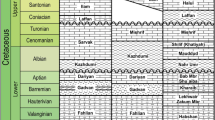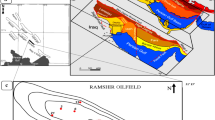Abstract
Reservoir facies determination is the most important job in oil exploration which dominantly relies on the major properties of rocks. Fundamental properties of rocks are usually understood by their detailed description in the field (lithofacies analysis) and laboratory (petrofacies analysis). The facies (lithofacies and petrofacies) determination in most subsurface studies is impractical, due to lack of cores and cuttings. In such situations, where the wire line logs are the only data available, the logfacies or electrofacies are determined instead. In this study, the available logs (gamma ray, density, Neutron, and sonic logs) for four wells (Am-1, Am-4, Am-5, and Am-6) were used to divide Mishrif Formation into seven units separated by barrier beds. Using cluster analysis in this study practiced the logfacies determination in each unit of Mishrif Formation in Amara oil field using Interactive Petrophysics software. The types of input data into Interactive Petrophysics software to determine logfacies are gamma ray log, porosity, and water saturation which are used to create 15 clusters and determine six groups of logfacies. In this paper, the vertical variations of logfacies for Mishrif Formation are carried out based on six groups of logfacies. These groups of logfacies are classified based on its reservoir properties such as porosity, water saturation, and shale content. In order to conclude the ability of application cluster analysis method, the logfacies of well Am-4 that predicated from cluster analysis were compared with the facies studied from examination of cutting samples.







Similar content being viewed by others

References
Al-Baldawi BAH (2012) Formation evaluation of Al-Mishrif Reservoir, Amara Oil Field, South Eastern Iraq.Unpublished M.Sc. Thesis, University of Baghdad
Aqrawi AAM, Goff JC, Horbury AD, Sadooni FN (2010) The petroleum geology of Iraq. Scientific Press, Beaconsfield, 424 p
Bellen RC, Van Dunnigton HV, Wetzel R, Morton D (1959) Lexique Stratigraphique International Asie. Iraq. Intern. Geol. Conger. Comm. Stratigr, 3, Fasc. 10a. pp. 333
Buday T, Jassim SZ (1987) The regional geology of Iraq, vol. 2. Tectonism, magmatism and metamorphism. Publication of GEOSURV, Baghdad, 352
Gill D, Shomrony A, Fligelman H (1993) Numerical zonation of log suites and logfacies recognition by multivariate clustering. AAPG Bull 77(10):1781–1791
Jassim SZ, Goff JC (2006) Geology of Iraq. Dolin, Prague and Moravian Museum, Brno, 341p
Missan Oil Company (2006) Final well reports for (Am-5, Am-6). Reservoir and Fields Development Department
Serra O (1986) Fundamentals of well log interpretation. The interpretation of logging data, vol. 2. Elsevier, Amsterdam
Tavakoli V, Amini A (2006) Application of multivariate cluster analysis in logfacies determinationand reservoir zonation, case study of Marun Field, South of Iran. JSUT 32(2):69–75
Author information
Authors and Affiliations
Corresponding author
Rights and permissions
About this article
Cite this article
Al-Baldawi, B.A. Applying the cluster analysis technique in logfacies determination for Mishrif Formation, Amara oil field, South Eastern Iraq. Arab J Geosci 8, 3767–3776 (2015). https://doi.org/10.1007/s12517-014-1490-z
Received:
Accepted:
Published:
Issue Date:
DOI: https://doi.org/10.1007/s12517-014-1490-z



